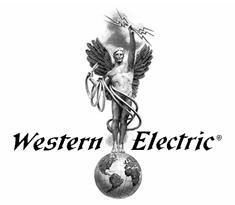

 |
 |
 |
The company manufactured W.E 13A horn we now know as Western Electric Company was U.S electrical engineering Company,
the manufacturing arms of Bell Telephone Company from 1881 to 1884. It was scene of a number of technological innovations and also some seminal developments in industrial management. Talking motion picture, one of their technological innovations was born 1927. Back to World War I era, during the rush to get the "doughboys" to Europe, it was decided that the traditional method of training a soldier to use a rifle, for example, was too slow. One man training another man, one-on-one, simply had to be eliminated in favor of a more rapid, and uniform method. It was decided that it would be a good idea to use the motion picture to do this, and so the first of the famous "Army Training Films" was born. Western Electric Company was there at the inception of this revolutionary concept. Someone in the bowels of the Western Electric Company - we will never know who - got the idea that if a moving picture could help the men learn how to use the Army rifle, one that talked could do it even better. Thus, the search to bring sound to the motion picture was born. However, in 1922, Research Administrator E. B. Craft decided to direct the company's developments in amplifiers, loudspeakers, microphones, and electronic recording in a new direction: towards sound motion pictures. Efforts towards that end had been tried since the dawn of motion pictures in the 1890's, most notably the introduction of the Kinetophone from Thomas Edison's laboratory in 1913. The Kinetophone's poor synchronization and sound quality proved more a distraction than an enhancement to films. Edison's failure made Hollywood moguls wary of expending much time or effort on sound--offering an opportunity to other innovators outside of the motion picture industry. By 1923, a number of companies were working on sound developments, but , Research Administrator E. B. Craft was undaunted by the competition. He wrote Frank Jewett, vice president in charge of research, "It seems obvious that we are in the best position of anyone to develop and manufacture the best apparatus and systems for use in this field." Craft turned out to be right. Western Electric developed an integrated system for recording, reproducing and filling a theater with synchronized sound. By 1924, Western Electric was ready to sell its system to Hollywood. |